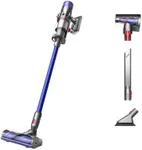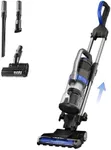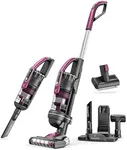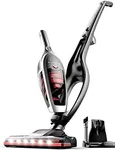Buying Guide for the Best Carpet Vacuums
Choosing the right carpet vacuum can make a significant difference in maintaining the cleanliness and longevity of your carpets. The right vacuum will effectively remove dirt, dust, and allergens, making your home healthier and more comfortable. When selecting a carpet vacuum, consider the following key specifications to ensure you pick the best fit for your needs.Suction PowerSuction power is the measure of how effectively a vacuum can pick up dirt and debris from your carpet. This is important because stronger suction ensures that even deeply embedded dirt is removed. Suction power is often measured in watts or air watts. For light cleaning, a vacuum with lower suction power (around 100-200 air watts) may suffice. For homes with pets or high foot traffic, a higher suction power (200+ air watts) is recommended. Consider your carpet type and the amount of dirt it typically accumulates to determine the right suction power for you.
Filtration SystemThe filtration system in a vacuum determines how well it can trap dust, allergens, and other particles. This is crucial for maintaining indoor air quality, especially for those with allergies or asthma. HEPA (High-Efficiency Particulate Air) filters are the gold standard, capturing 99.97% of particles as small as 0.3 microns. If you have allergies or pets, opt for a vacuum with a HEPA filter. For general use, a standard filter may be sufficient, but ensure it is easy to clean or replace.
Weight and ManeuverabilityThe weight and maneuverability of a vacuum affect how easy it is to use, especially if you have a large home or multiple floors. Lightweight vacuums (under 10 pounds) are easier to carry and maneuver, making them ideal for quick clean-ups and smaller spaces. Heavier vacuums (over 15 pounds) often have more powerful motors and larger dust capacities, suitable for thorough cleaning of larger areas. Consider your physical strength and the layout of your home when choosing the weight and maneuverability of your vacuum.
Dust CapacityDust capacity refers to the amount of dirt and debris a vacuum can hold before it needs to be emptied. This is important for convenience and efficiency, as larger capacities mean less frequent emptying. Bagless vacuums typically have transparent dust bins, making it easy to see when they need to be emptied, while bagged vacuums often have larger capacities and can be more hygienic to empty. For small apartments or occasional use, a smaller dust capacity (around 0.5 liters) may be sufficient. For larger homes or frequent use, look for a vacuum with a capacity of 1 liter or more.
Attachments and AccessoriesAttachments and accessories enhance the versatility of a vacuum, allowing you to clean various surfaces and hard-to-reach areas. Common attachments include crevice tools, upholstery brushes, and pet hair tools. These are important for tackling specific cleaning tasks, such as removing pet hair from furniture or cleaning tight corners. If you have pets, look for vacuums with specialized pet hair attachments. For general cleaning, a basic set of attachments will suffice. Consider the types of surfaces and areas you need to clean to determine which attachments are necessary for you.
Noise LevelThe noise level of a vacuum can affect your comfort and convenience, especially if you have young children, pets, or sensitive hearing. Noise levels are measured in decibels (dB), with lower numbers indicating quieter operation. Vacuums with noise levels below 60 dB are considered very quiet, while those above 70 dB can be quite loud. If you prefer a quieter vacuum, look for models specifically designed for low noise. For general use, a moderate noise level (around 65-70 dB) is usually acceptable. Consider your household's tolerance for noise when choosing a vacuum.























